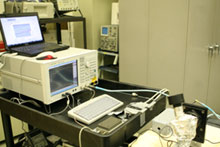Beaming Broadband Across the RoomWireless optical networks could provide gigabit-per-second data transfer.
A wireless network that uses reflected infrared light instead of radio waves has transmitted data through the air at a speed of one gigabit per second--six to 14 times faster than the fastest Wi-Fi network. Such optical networks could provide faster, more secure communications and would be especially suitable for use in hospitals, aircraft, and factories, where radio-frequency transmission can interfere with navigation equipment, medical devices, or control systems. Another possible application is wireless networking for home theaters; a system that transmits data at 1.6 gigabits per second could broadcast two separate high-definition TV channels across a room, a capacity that exceeds the bandwidth of any existing radio system.
Penn State graduate student Jarir Fadlullah and Mohsen Kavehrad, professor of electrical engineering and director of the university's Center for Information and Communications Technology Research, built and tested the experimental system. Their setup sent data across a room by modulating a beam of infrared light that was focused on the ceiling and picking up the reflections using a specially modified photo-detector. The pair says that their measurements show the system could support data rates "well beyond" the one gigabit per second they are currently claiming. "This probably will be the next generation wireless communications technology," says Zhengyuan Daniel Xu, professor of electrical engineering at the University of California, Riverside. Xu is also the director of the UC-Light Center, a consortium of researchers working on wireless optical communications at different UC campuses. "Light will give you higher data rates than radio frequencies, and RF already has a very congested spectrum." Optical wireless networks could also offer less interference and greater security than radio-frequency networks, Kavehrad says. While radio signals pass through walls and doors, light does not, making it easier to reuse frequencies and more difficult to intercept transmissions. He also notes that unlike radio frequencies, the spectral region for all light--infrared, visible, and ultraviolet--is unregulated worldwide. This could make it easier to commercialize optical wireless networks. Researchers have studied indoor optical communications since the late 1970s, when engineers at IBM Zürich built the first working system. The technology languished because the Internet was still in its infancy, and there was no demand for wireless broadband systems--though interest has picked up in the past few years. Kavehrad's demonstration is by far the highest speed that's been demonstrated for an indoor wireless optical network, says Valencia M. Joyner, assistant professor of electrical and computer engineering at Tufts University. She notes that the transmission distances that he and Fadlullah achieved, and their use of diffuse light rather than a point-to-point optical system, are especially important. "There are a lot challenges in demonstrating the high-speed capabilities of indoor optical signals," she says. "The fact that he was able to demonstrate a one-gigabit-per-second system with diffuse light is extremely significant. That drastically reduces the complexity of the transceiver system." |
New Hope for
Optical Signal Processing
11/01/2006


Tags
optical fibers WiFi wireless networks